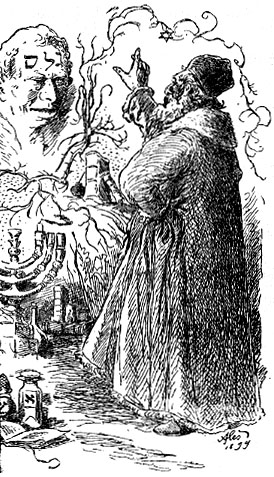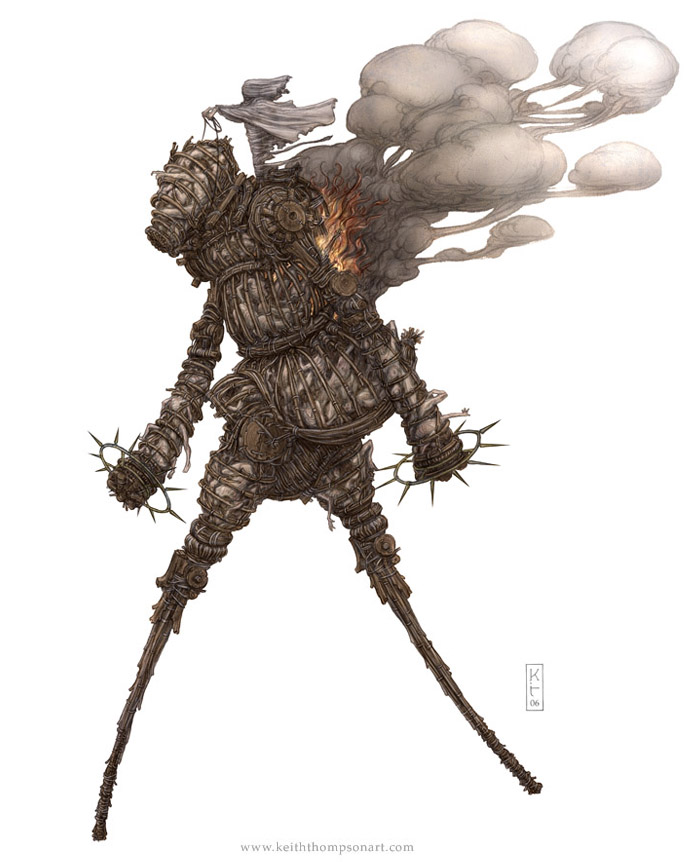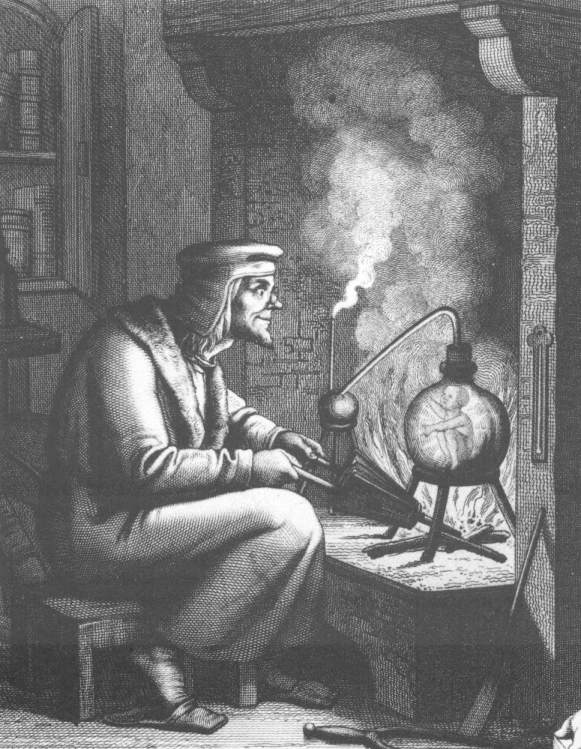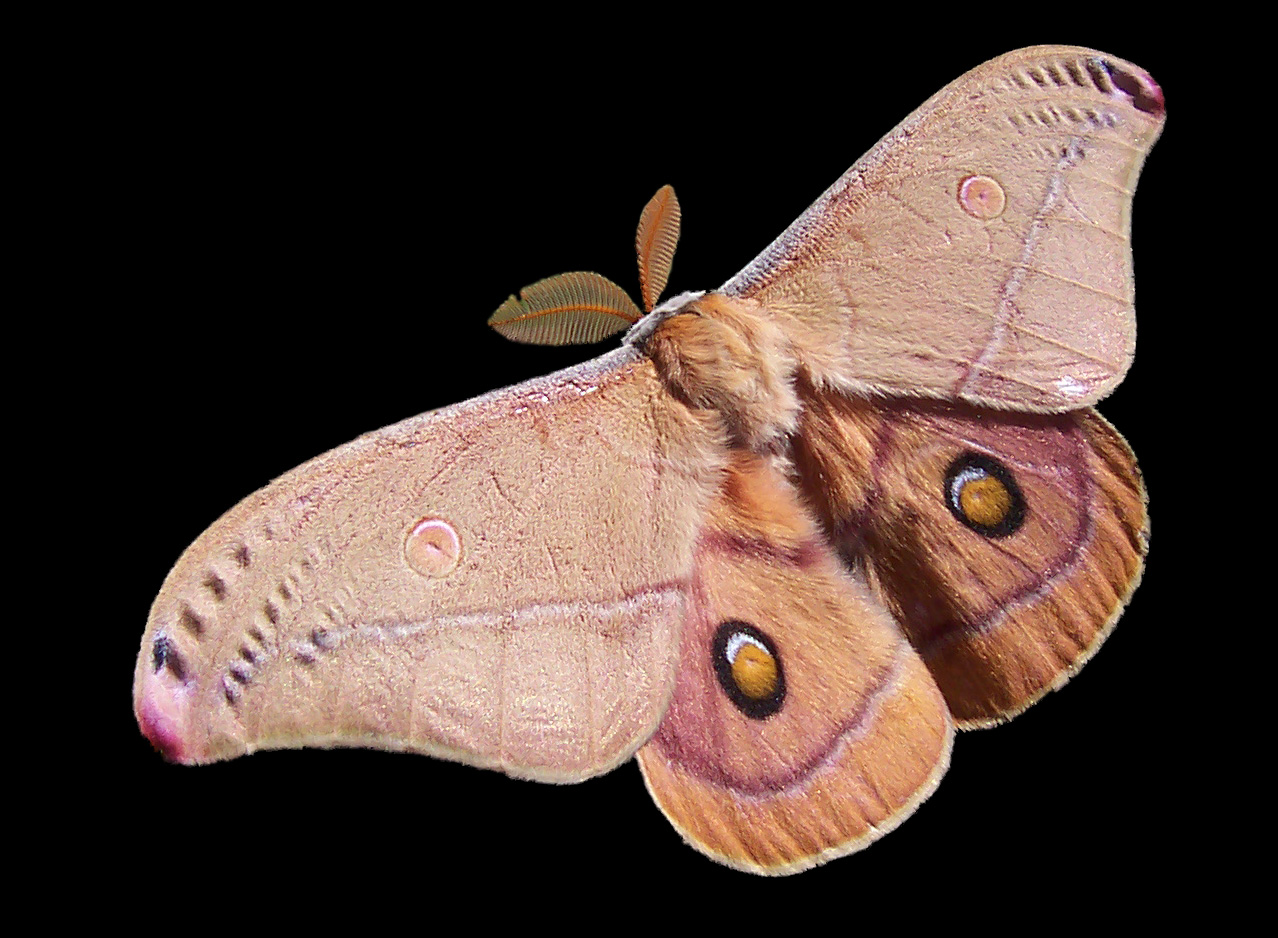In the rain-soaked city of Ischaim, cloistered scholars and rabbis perform sacred rites and incantations over holy simulacra of men, designed to impart life and stewardship into these guardians of the faithful. You are not a holy man, or one of the faithful. The secrets of golemistry were leaked to the arcane public, losing the trappings of religion in the process. Now golemistry is utilized by most major countries, and wandering golemists fill secretive clubs and barrooms with hulking clay bodies, glimmering in the firelight.
This class was inspired by a lot, notably Judah Low from Iron Council and the State Alchemists of FMA. I wanted something like a summoner class that drew upon their surroundings for quick minion creation in combat. It’s kinda like a spellcaster if they only had one spell that got more specific as they levelled up. I’m not sure it’ll work, since I haven’t really tested it, but it was fun to write. Maybe in time, after some testing, I’ll give it another writeup and spruce it up (but probably not).
I wrote it as a competition with Spwack over in the OSR discord. Check out his Golemist class (I have no doubt his actually works) and his other stuff, it’s all very good and weird. I've never written a GLOG class before, so this was a really fun way of getting into things!
 |
| Mikoláš Aleš |
Golemist
Starting Equipment: Notebook, dagger, set of brushes and inks, roll on your favorite random item list.
Perk: You can block out any external stimuli that would cause you to lose concentration on your work.
Downside: Any HP you use to create a golem can’t be regenerated by any means until that golem is dismissed.
For every Golemist template you have, gain +2 HP
A: Dismissal, Animate Lesser Golem
B: Understanding, Animate Common Golem
C: Usurp Command, Esoteric Material
D: Efficiency, Animate Greater Golem
To create a golem, you touch an object and invest a portion of your body and soul, in the form of HP. Each golem type has different HP requirements from you. I.e., you cut yourself for 1 HP and invest it into making a lesser golem. That golem has 1 HP, and you can’t regain that 1 HP until the golem is dismissed. Golems are brought to life by an arcane word inscribed in blood on their bodies somewhere. If this word is marred or erased, the golem is destroyed.
You start off being able to make clay or mud golems.
.jpg) |
| Universal Studios |
Dismissal
You can instantly dismiss any golems you control with a thought, rendering them insensate matter once more. Greater golems get a save, while rogue golems have to be manually erased.
Animate Minor Golem
Spend 1 HP per golem HP to imbue a material or conglomerate of material with a portion of soul and the semblance of life. They can only follow simple commands (“Go for their legs”, “Protect this doorway”). Lesser golems are smaller than a human. Each HP you spend is one golem HP.
Understanding
You study something at a fundamental level, and gain an insight to it unrivalled in the field. Takes 1 hour of uninterrupted extrospection (30 minutes with proper equipment like a 10 gp microscope) on a solid you can examine with your tools and hands. Save vs. forgetting what you learned while you sleep, after three successes the knowledge is permanent. While you understand something, you have advantage on identifying it in other materials, and you know the best ways to kill or neutralize it. You can also create golems out of that material from now on, and golems made of that material go rogue 5% less.
Animate Common Golem
Cost 2 HP per golem HD. Your golems can be bigger (human to ogre sized), and more complex. They follow fairly complex or sequential commands.
Usurp Command
If you meet another golemist on your road, kill him and take his golems. You can impose your will over other constructs. Their controller gets a contest (or the golem does do, if it’s controller is dead). On a fail, take 1d6 psychic damage, and all your currently active golems are dismissed.
Esoteric Understanding
Your golems are stranger, utterly unique. You can use your gift of understanding on even stranger or more complicated things, like radium, air, ideas, or anti-matter. Up to GM discretion. Normal material understanding no longer needs a save vs. forgetting. Reduces all rogue chances by 5%. Stacks with understanding.
Efficiency
You bypass the Golem-Master Bond problem, allowing you to regain half the HP you invest when you create any golem. The HP is still drained, but you can regain half (rounded down) while the golem is still active.
Animate Greater Golem
Invest 3 HP per greater golem HD. These creations are thinking, sapient. Act as a hireling that is utterly devoted to you. See below on greater golem building.
Saddleback. Allows the golem to be ridden like a horse or riding lizard or whatever creature you want. Moves like an elephant. Costs 3 HP during creation.
Gun Barrel. Your golem can shoot cannon balls for 4d6 damage on a hit. Costs 6 HP, and you need a cannon on hand (or enough raw material to make one, I guess.)
Many-Legged. Your golem has more than two legs, possibly far too many. It cannot be knocked over. Costs 3 HP.
Amorphous. The whole thing is made of wet clay, living flesh, protoplasm, or other gooey substance. It can be cut in half and survive, and eventually reconstitute itself. Costs 6 HP.
Shell. The golem is hollow, with a space inside for you, the creator. Basically a mech suit, gives you the physical stats of the golem and AC like plate. Costs 6 HP.
Bladed. Covered in metal teeth, shards of glass, actual swords, sharpened bits of bone, planes of refined entropy. Does 2d6 damage on contact, really good at grappling. Costs 3 HP.
 |
| Keith Thompson |
Rogue Golems
Creating a golem is a difficult undertaking. The more complex the mind, the more likely the golem is to break free of your mental restraints and act on its own initiative. This is known as “going rogue”. Whenever you create a golem and the first time you ask it to put itself in harm’s way for you, roll 1d100.
Lesser golems: 10% chance of going rogue
Common golems: 20% chance of going rogue
Greater golems: 45% chance of going rogue
 |
| Keith Thompson, again |
A Few Example Golems
Here are some golems statted up so you can see what they do and how to model them in your games.
Scissor Golems. 2 HP. AC as rat. Tries to cut your tendons or stab your feet for 1d4 damage. MOV as rat. MORALE 20. Flock like piranha. They don’t do much damage if you’re wearing good boots, but god help you if you trip and fall.
Door Golem. 3 HD. AC as Plate. Can’t really attack, but will slam itself shut on your fingers if it has to, 1d4 damage. MOV 0. MORALE 20. Used as guardians, like sphinxes. If you answer the riddle correctly or know the secret password, the way is opened for you. Forgetful mages tend to include hints to their passcodes.
Clay Golem. 1 HD. AC as Leather. Pummels you with rock-like fists for 1d6 damage. MOV as human. MORALE 20. Stolid, dependable, unoriginal. Look for the secret word on its forehead or in its mouth.
Ball-of-Flesh Golem. 2 HD. AC as unarmored human. Rolls over you, slashing at you with random appendages for 1d6 damage. 50% chance of trying to suffocate you and add you to its mass. MOV as horse. MORALE 20. When most people see a bunch of strewn bodies, they see carnage. You see raw material.
Oliphaunt Golem. 6 HD. AC as Plate. Hits like a fucking tank, tusk-blades do 1d8 slashing while the gun in place of its head shoots for 4d6 damage. MOV as elephant. MORALE 20. Not only is it huge and dangerous, it is cunning, and seeks only to aid its creator.
 |
| Artist unknown, from Goethe's Faust |
What Your Golem Does When It Goes Rogue
- Attacks everything in sight, including inanimate objects.
- Attacks only you, then leaves out the nearest exit.
- Screams without lungs or vocal chords, then collapses back into whatever original matter it was constructed from.
- Obeys your commands a millisecond slow, then sneaks away at its first opportunity.
- Walks in a counterclockwise spiral until it hits an object, then reverses around it.
- Begins eating everything it can fit in its mouth. If it doesn’t have a mouth, it just mashes the things on its face. The objects aren’t actually eaten; they’re still inside it, crushed and covered in clay.
- Attacks everything but you.
- Carries you to the next room/building/clearing/area then collapses.
- Is entirely unresponsive.
- Moves at one quarter of its normal rate; every attack is telegraphed so far in advance anyone can get out of their way.
- Constantly emits noise/smoke/sparks, thwarting any attempts at stealth or polite conversation.
- Walks backward, trips on everything.
- Obeys only the most simple and direct orders. Like playing a text-based game. Even “Go through the door” will cause it to overheat and lock in place.
- Whatever it wants. It is now an NPC. It remembers everything you’ve done to it, including while it was the base material.
- Shadows your every move, obeys none of your commands.
- Begins scratching every word and discernable noise it has heard on the wall/floor in dictation.
- Does the literal opposite of all of your commands.
- Uses whatever appendage is able to smash out its own word, crippling or killing itself.
- Gets visibly hot, then explodes for 6d6 damage.
- Transmutes to a new substance, then discorporates.










